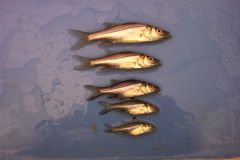
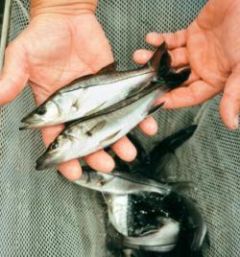
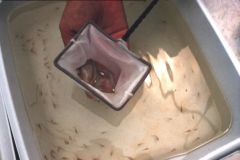
Spawning
Snook
Mote began developing the technology to culture snook in the 1990s. Initial
efforts were focused on catching wild snook broodstock during the spawning
season and transferring them to tanks at
| To collect the snook eggs a group of 8-10 staff deploy a 400 ft by 10 ft seine net off the back of a netting boat. The netting sites are chosen based on known locations of snook spawning groups and the manageability of pulling in the large seine net. Typically, spawning snook congregate near passes and inlets into the bay. Although there are many sites that snook congregate for spawning, the currents or topography of the site may be too difficult to net. | 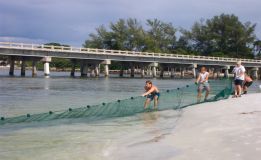 |
|
After the fish are collected in the seine, they are then separated by sex into floating pens called "hapas". Milt (male sperm) it taken from the males and eggs are taken from the females and the fish are released. The eggs and milt are then combined with seawater to fertilize the eggs. The eggs are then carefully packed in bags and transported to Mote where they are stocked in larval rearing tanks. |
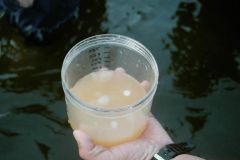 |
Current
research efforts are focused on developing year-round captive maturation and
spawning techniques for snook. Knowledge from such research would enable
us to make greater breakthroughs in the larval rearing of this important
recreational species. In 2004, we began rearing snook broodstock (adult
snook) in the 14,348 gallon tanks at Mote's Aquaculture Park (MAP). The snook
broodstock systems are designed to hold up to 50 kilograms of fish
(approximately 14 adult snook).
Snook
Larval and Juvenile Research
The Marine Aquaculture Research Program is also concentrating its snook larval and juvenile research efforts on improving increasing survival in larval rearing, increasing survival in nursery culture by reducing cannibalism, and reducing the incidence of lordosis in cultured snook. Snook start off their lives as very small larvae (approximately 1.5 mm or 0.06 inches). This small size means that they require very small food organisms after hatching. Larval snook are initially fed rotifers, a small zooplankton (approximately 100 micrometers or 0.00039 inches). Rotifers are fed algae to survive and enhance their nutritional profile. Larval survival is not optimal on an initial rotifer diet; thus, our research is focusing on identifying alternative first feeds for larval snook.
Another area of research is the reduction of cannibalism in nursery-stage snook. When snook metamorphose from the larval to the juvenile or nursery stage (25-30 days after hatch), they are very cannibalistic. Snook are so aggressive that they will try and swallow a fish of the same size. This extreme aggression among juvenile snook makes it necessary to size grade the fish on a routine basis. However, even with frequent size grading, the aggressive behavior makes it difficult to rear these animals in high densities. Research is underway to determine if culture conditions can be modified to reduce aggression in nursery culture systems.
The
incidence of lordosis or bent-back syndrome in hatchery reared snook varies
from year to year. Research conducted to date, suggests that this deformity results
from nutritional deficiencies in commercial fish diets. Research is underway to
determine if we can reduce the occurrence of lordosis in juvenile snook through
modifications in the nutritional makeup of the diet.

